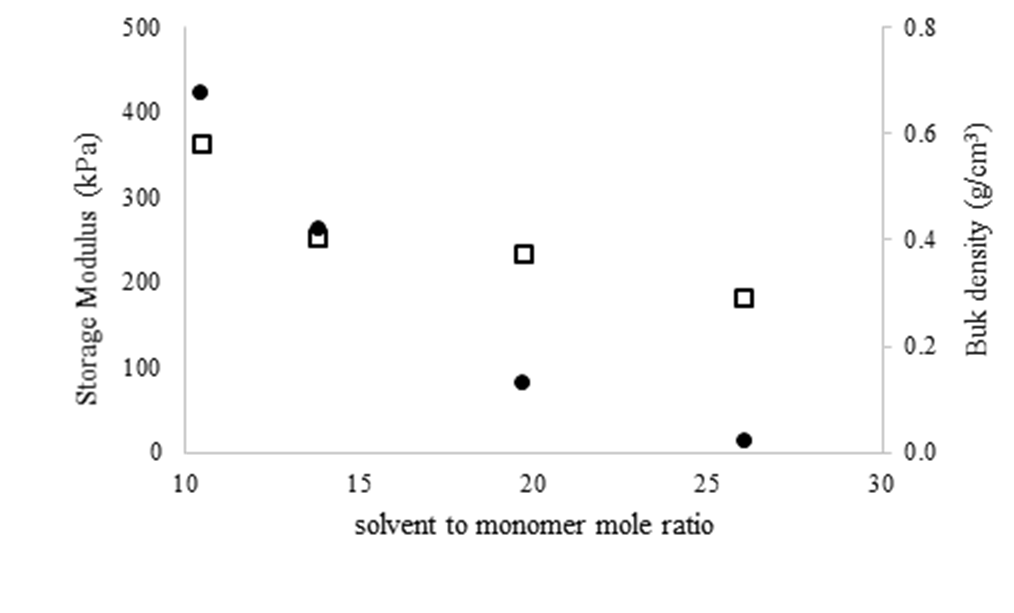Reports: ND754596-ND7: Synthesis, Functionalization, and Characterization of Crosslinked Porous Elastomers
Robert B. Grubbs, State University of New York at Stony Brook
Overview:
This project explores the polymerization of petroleum-derived cycloolefins for the preparation of porous crosslinked elastomers (PCEs). (Scheme 1) This class of monomers is amenable to synthetic manipulations and thus offers a facile route to a variety of functionalized PCEs. Such materials have not been extensively explored, but would be valuable in applications involving tissue engineering, substrates for flexible electronics, and low impact cleaning materials for fine art. In this regard, we have proposed to (1) optimize PCE synthesis (2) prepare functionalized PCEs and (3) prepare materials suitable for model applications.
Scheme 1.
During the second funding period (9/2015-8/2016), we have investigated the following:
- Continued investigation of ring opening metathesis copolymerizations of cyclopentene (CP) and dicyclopentadiene (DCPD); cyclooctene (COE) and DCPD; CP, COE, and DCPD; and CP with novel crosslinkers have been explored and targeted for desired elasticity targets.
- Small amplitude oscillatory shear (SAOS) rheological characterization of PCEs was conducted. Dynamic moduli were related to polymer compositions.
- Thermal and mechanical degradation of PCEs was studied by Evolved Gas Analysis (EGA).
- Preliminary application studies of different PCE compositions for cleaning surfaces.
Key Findings:
Our continuing synthetic efforts have focused on the copolymerization of cyclopentene (CP) and/or cyclooctene (COE) with dicyclopentadiene (DCPD) under precipitating conditions. Early difficulties in optimization of the CP/DCPD system led to exploration of new monomer/cross-linker systems. Promising results have been obtained working with cyclooctene (COE) based terpolymer systems as well as polycyclopentenamers crosslinked with tetraethylene glycol dinorbornenyl acetate (Nb2-TEG) (Scheme 2). In order to combat rapid oxidation of samples, 0.1-0.2 mol% of an anti-oxidant monomer (e.g., Nb-BHT) was incorporated into all samples. A CP/COE/DCPD terpolymer polymerized with Nb-BHT showed minimal oxidative damage by IR after 30+ days storage under ambient conditions. The rheological properties of these new PCEs have been investigated in order to establish structure-property relationships in the materials. For example, the solvent:monomer ratio in COE/DCPD copolymerizations has a strong influence on both the storage modulus and density of the resulting PCEs (Figure 1).
Scheme 2.
Figure 1. Storage (Elastic) moduli (G′: filled circles, ●) and estimated bulk density values (open squares, □) of a series of p(COE-co-DCPD) copolymers prepared at different monomer concentrations.
One potential application of these materials is for the removal of dust and other contaminants from sensitive surfaces, such as paintings. In preliminary efforts to explore the cleaning ability of the new PCEs, we have studied the removal of model contaminants (ground charcoal, copper oxide dust) from model surfaces (filter paper, canvas), and examined the model surfaces for any residue left after rubbing the model surface with PCE samples. The PCEs themselves were found to contain low volatile and residual metathesis catalyst contents (70 ± 18 ppm by ICP-MS), with little if any detectable residue left on rubbed surfaces. The viscoelastic properties of the PCE were found to have a substantial effect on dirt pick up on smooth, primed canvas surfaces. PCEs with storage moduli near 150 kPa were found to have a good balance between viscous and elastic properties required to conform to a surface and adhere to model contaminants. Although the precipitation conditions and polymer surface energies are anticipated to similarly play a role in cleaning efficacy, their behavior was found be more subtle and irreducibly related to the viscoelastic characteristics of the PCE.
Impact.
The PRF award has afforded an opportunity to pursue a new direction of research exploring the preparation of porous elastomers via ROMP methodologies. It has provided training and support for one postdoctoral researcher, as well as two undergraduate students in the general field of polymer synthesis and materials characterization. Additionally, this project has fostered collaboration with conservators / art conservation scientists at the Metropolitan Museum of Art in NY. One publication is in preparation. Dr. Anna Flach gave a talk on this project at the Gordon Research Seminar for Scientific Research in Cultural Heritage and a poster at the associated Gordon Research Conference in August 2016.














